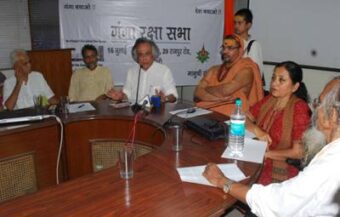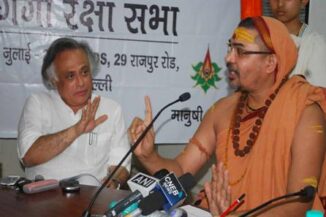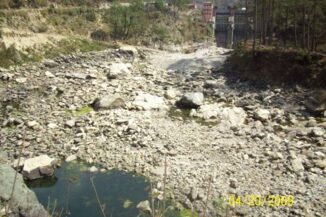Resolves of the Emergency Meeting to decide Plan of Action against the illegal decision of the GoM to allow resumption of Loharinag – Pala Power Project
This article was first published on the website, “India Waterportal”. (Jul, 2010)

Shankracharya designate Swami Avimukteshwaranand ji presided over an emergency meeting organized by Manushi Sangathan, Ganga Ahvaan and Ganga Yamuna Jal Biradri to express our strong protest against the patently illegal decision of the Group of Ministers giving clearance to the Loharinag-Pala dam on the Ganga River. The following expert members of the NGRBA also participated in the meeting to express their strong protest having been kept in the dark about the appointment of the GoM which has passed a virtual death sentence on the most sacred river of India: Rashid Hyatt Siddiqui, Rajendra Singh, Rama Raota and Ravi Chopra. Environment Minister Jairam Ramesh also joined the meeting for two hours to explain the Government’s stand.
GoM Takes illegal Decision: It was communicated to the Minister that we consider this decision illegal and in bad faith for the following reasons:
- The Ministry of Environment has admitted that the Loharinag Pala Project does not merit environmental clearance. In fact, the list of serious violations of basic environmental laws with already visible disastrous consequences is so long that those who went ahead with the Project would deserve stringent punishment if the Government put in place an honest system of evaluation and implementation of its own laws.
- The GoM was appointed by the Prime Minister without the knowledge of the 9 expert members of the National Ganga River Basin Authority. They came to know of its existence only through press reports on July 12 that the GoM had given the project a go ahead. It is not clear whether Dr Manmohan Singh appointed the GoM in his capacity as the Prime Minister or in his capacity as the Chairperson of the NGRBA. In either case, it is a blatant attempt to undermine the authority and credibility of NGRBA. Noted Supreme Court lawyer Mr. MC Mehta who participated in the meeting confirmed that the GoM has no legal standing and that its decision is a brazen violation of the mandate and authority of the NGRBA.
- This decision of the GoM is in clear violation of the following commitments made by the GoI:
- The written assurance given by the Ministry of Power to Professor G D Aggarwal after his indefinite fast in 2008 that the Government would ensure an environmental flow for Mother Ganga. Professor Aggarwal has already informed the Power Minister that this betrayal by the Government leaves him no choice but to resume his fast unto death from July 20, 2010.
- The public assurances given by the Minister of State for Environment on February 10, 2010 in Delhi before an all India Ganga Panchayat organized by the Ganga Jalbiradri and Manushi Sangathan comprising of important religious leaders and concerned citizens as well as at Matri Sadan on April 7, 2010 in Haridwar that the aviralta and nirmalta (uninterrupted ecological flow) of river Ganga would be ensured and these destructive dams would be scrapped. This promise had given us hope that the Central Government would put a halt to further destruction of our sacred rivers and the mighty Himalayas.
- A team of three experts of NGRBA authorized by the Authority to visit the Project sites and prepare a report on the environmental impact of these Projects had given a very adverse report and unanimously recommended as recently as March 2010 that the Loharinag-Pala dam be decommissioned.
- The decision taken by the GoM under the chairmanship of Mr Pranab Mukherjee can at best be treated as a recommendation because the deciding power actually vests with the Ganga River Basin Authority, which has not given any such clearance. Unfortunately, the construction company and the contractors involved in the project have taken it is a go-ahead signal to resume work on the dams. It is the responsibility of the Environment Ministry to ensure that the work on these destructive dams should remain suspended till a final decision is taken by the Ganga River Basin Authority.
Given the sense of betrayal felt by almost all who participated in the well attended meeting the following decisions were taken unanimously:
-

Swami Avimukteshwaranand and Mr Jairam Ramesh engaged in heated arguments An Action Committee was constituted to launch a widespread campaign to demand the scrapping of the Loharinag Pala dam. This will be headed by Swami Avimukteshwaranand and comprise of the representatives of the following organizations: Ganga Sewa Abhiyan, Chinmaya Mission, People’s Science Institute, Ganga Ahvaan, Tarun Bharat Sangh, Ganga Jal Biradari, Matri Sadan, Save Ganga Movement, MC Mehta Environmental Foundation, Ganga Yamuna Jal Biradari and Manushi Sangathan.
- As the authorized representative of the Shankracharya of Dwarka and Jyotirmath, Swami Avimukteshwaranand ji will lead a delegation to meet Dr Manmohan Singh in his capacity as the Chairperson of the NGRBA to lodge a strong protest against the arbitrary and illegal decision of the GoM giving a green signal to Loharinag Pala project which will open the way for the 300 bumper to bumper dams proposed on Ganga and its tributaries.
- Our delegation will demand that either this decision be reversed or the Prime Minister disband the NGRB Authority because this supposedly high powered body has no meaning if its functioning can be sabotaged through underhand means and its authority undermined by ad hoc GoM’s appointed by the PM.
- A chain of volunteers, including Swami Avimukteshwaranand and Swami Nikhilanand ji of Chinmaya Mission would join one after the other in support of Prof Aggarwal’s satyagraha. Ganga devotees in different parts of India would organize satyagarahas in their respective regions to lend strength to Prof Aggarwal’s fast.
- We will demand that NGRBA organize a well planned and well publicized Public Hearing and institute a Public Audit of Loharinag Pala and related power projects in order to facilitate a transparent mechanism for reviewing these projects. This should include widespread participation of villagers directly affected by these projects. This should become a standard procedure for all major power projects.
- The next meeting of our Action Committee would be held on July 23, 2010 a day before the Standing Committee of the NGRBA on the 24th of July.
- If the Government cannot maintain the sanctity of River Ganga, it should withdraw the special status bestowed on this ganga by declaring it as a National River so that citizens take their own measures to protect its sanctity instead of depending the government to do its bit.
Report of the Proceeding: The Minister of Environment reacted angrily when Swami Avimukteshwaranand expressed his disappointment at the GoM’s decision by telling Mr Ramesh that he had failed his responsibility as environment minister by falling in line with an ecologically disastrous decision which also overlooked the deep religious and spiritual sentiments of millions of Indians who cannot remain mute witness to the
destruction of river Ganga whose sacred waters cannot retain their unique purity if Ganga is enslaved in bumper to bumper dams right in its catchment area. Swami ji further added that the sense of betrayal was deep because we thought Mr Ramesh was not the usual run of the mill politician who thinks nothing of breaking his promises.
Leading environmentalist Mr Ravi Chopra spoke for several members of the NGRBA when he expressed his distress before the gathering in the following words: “We feel used by the Government. They call us for meetings only when they need our support. But when we want to discuss something that demands urgent attention, we get no response whatsoever. This manner in which this decision has been arrived at and communicated makes a mockery of the NGRBA headed by Dr Manmohan Singh”
Almost all of those who attended the July 16 meeting felt deeply disappointed by the explanations offered by Mr Jairam Ramesh justifying the GoM decision. His main argument was that India with its 1.4 billion strong population needed power from all possible sources for “economic progress and development.” He could not answer whether people could survive, leave alone “progress” without water which is what is becoming dangerously scarce as a consequence of mindless destruction of our eco system. Today, Himalayan villages on the banks of Ganga and its tributaries are water starved because most springs have dried up on account of mindless blasting and bumper to bumper dams being built on the river. Farm animals are dying, fields are being abandoned and people perforce depend on filthy water supplied in dirty drums through tankers for their drinking water needs. Some of us who recently visited the Project site were saddened to see how after being pushed out of agriculture, families in the Himalyas are either migrating to the plains or setting up petty shops selling tobacco masalas, cigarettes, Coca Cola, chewing gums, candy and Pepsi packaged potato chips to visitors in order to eke out a living.
The participants were also not convinced by Mr Jairam Ramesh’s assertion that there were no viable alternatives to hydro power.

What is worse, the existing power projects are yielding much lower amounts of electricity than promised because the once mighty River Ganga has been reduced to a mere trickle. Mallika Bhanot and Hemant Dhyani pointed out that in response to an RTI filed by Arya Vihar Ashram the Government has admitted that Maneri Bhali Phase 1 power project built with a promise of mere 90 megawatt capacity located 15 kilometers upstream from Uttarkashi is functioning at a mere 40% capacity because of heavy siltation during monsoon months and reduced water supply in winter months due to receding glaciers.
How then did the government expect 600 megawatts of power from the Loharinag-Pala project when it is located nearly 60 kilometers upstream from Uttarkashi, especially considering that by the time Ganga reaches Maneri Bhali it has much greater volume of water flow because 13 small tributaries add its flow
It was the unanimous view of the gathering that these projects are not really meant for making power. Their real purpose is to make money for the Babu-Neta-Contractor Combine. Government was partial to exorbitant hydro projects because they facilitated large scale loot of public money.
The second explanation offered by Jairam Ramesh for reviving the suspended Loharinag Pala Project provoked a very heated exchange. He informed the gathering that the Government could not afford to abandon the Project because Rs 600 crores had already been spent on this Project while an additional Rs 2000 crores had been committed on account of equipment ordered for the project construction. The gathering found this inflated estimate unacceptable. At the time of Prof GD Agrawal’s fast unto death to save Ganga in 2007, the Government claimed to have spent Rs 400 crores on the Project. Thereafter the work had remained suspended. By February 2010, the Environment Minister claimed in a meeting organized by Manushi and Ganga Jal Biradri that the Government had spent Rs 600 crores. That is when Swami Avimukteshwaranand had offered to raise the full amount through donations by Ganga devotees to make good the loss provided the Govt. signed an MOU that it would scrap the Project if the money were reimbursed. We asked Mr Ramesh how could the Government order equipment worth Rs 2000 crores when it had not received environmental clearance.
When Avimukteshwaranand ji reminded Mr Ramesh that he had offered to raise the ransom money for freeing Mother Ganga of destructive dams, the latter dismissed it saying it was not a realistic offer and that such a huge amount could not possibly be raised through public donations. This enraged Swami ji who told the Minister that he was acting in bad faith and had no business to pass such a negative judgment on the commitment of Ganga devotees without giving them a chance to prove themselves.
However, the Environment Minister did openly declare that personally he was in favour of scrapping the Loharinag-Pala and other 300 bumper to bumper planned projects on Ganga and its tributaries because they were destroy not just the Ganga but also cause irreparable damage to the fragile Himalayas. But everyone was appalled when the very next moment he defended the Government’s decision on account of the abovementioned fiscal reasons. Most of us felt that Mr Ramesh owed to his own office to take a firm stand on the issue instead of buckling under the pressure of the Power and the Finance Minister.
The Minister showed great annoyance when Mallika Bhanot and Madhu Kishwar confronted him with two simple questions: If the Loharinag–Pala Project involves serious violation of environmental laws that he is expected to uphold, how then has he given a clearance to this Project as a member of the GoM? Why did he not inform the non government experts of NGRBA about the GoM?
Mr Ramesh’s evasive answers caused deep disappointment especially since he has always claimed that he is a convinced supporter of the Save Ganga movement and represents the cause of Ganga within the government.
The ball is once again in the citizens’ court. We have to do all we can to force the Government to act lawfully and responsibly in order to Save Mother Ganga from being destroyed by the greed of politicians and contractors.






